Fault Detection and Localisation in LV Distribution Networks Using a Smart Meter Data-Driven Digital Twin
Abstract
:1. Introduction
2. Proposed Digital Twin-Assisted Fault Detection and Localisation Method
2.1. Overview of the Proposed Digital Twin
2.2. Scottish Power Energy Network-Based Digital Twin
2.3. Proposed Two-Stage Fault Detection, Identification, and Location
2.4. Fault Identification ML Features Engineering
2.4.1. Smart Meter Voltages and Cables’ Current Symmetrical Components
2.4.2. Data-Driven Feature Extraction
3. Simulation, Data Preparation, and ML Model Training
3.1. Fault Scenario Design
3.1.1. High-Impedance Shunt Fault Scenarios
- Faulted cables: The study encompassed faults occurring in all 39 cables of the feeder, with each cable subject to the following variations.
- Percentage of faulted cable length: Fault scenarios were generated with varying percentages of the faulted cable length, ranging from 0% to 100% at 10% intervals.
- Fault types: Four distinct high-impedance shunt fault types, i.e., Line to Ground (LG), Line to Line (LL), Line to Line to Ground (LLG), and Three-Phase (3Ph) faults were considered.
- Faulted phases: Faults were induced in each of the three phases (A, B, and C) individually to account for the faults at different phases.
- Fault resistance (): A range of fault resistances (in ohms) was employed to emulate the different fault conditions, with values of (0.2, 0.3, 0.4, 0.5, 0.6, 1, 1.5, 2, 3, and 5) k. These values were chosen to emulate the case of high-impedance shunt fault values.
- System loading: Four different system loading conditions were considered, with values of [0.5, 0.9, 1.5, and 2] kW. These represented different levels of network utilisation for the given feeder. The implied range takes into account the yearly and daily system loading variations.
3.1.2. Open Conductor Fault Scenarios
- Faulted cables: Similarly, the open conductor analysis was performed on all of the 39 cables in the network.
- Percentage of faulted cable length: Unlike the case of high-impedance shunt faults, the percentage of the cable at which the open conductor fault occurred did not have a significant impact on the readings; however, the results were augmented with varying percentages of the faulted cable length, ranging from 0% to 100% at 10% intervals.
- Faulted phases: Open conductor fault scenarios covered all of the permutations of a single-phase outage (A, B, and C) and of the phase combinations (AB, BC, AC, and ABC).
- System loadings: The same four system loading conditions (0.5, 0.9, 1.5, and 2) kW were utilised to capture the impact of varying network utilisation on fault identification and location.
3.2. Simulations and Training Dataset
- The first 6 columns were for defining the fault scenarios: fault type, phase, cable, location percentage, fault resistance, and loading.
- The following 57 () columns were for the A, B, and C RMS voltage values for each of the 19 loadings, where only the connected phase had a null value for the other two phases.
- The remaining 117 () columns corresponded to the currents’ zero, positive, and negative sequence components () for each of the 39 cables.
3.3. Machine Learning Models
3.3.1. Value of the Current Symmetrical Components’ Estimation Stages
3.3.2. Load Voltage/Cable Current Regression Model
3.3.3. Fault Location Classification Model
3.3.4. Fault Type Identification Classification Model
3.3.5. Detailed Overview of Machine Learning Models
- (a)
- The Random Forest Regressor
- (b)
- Decision Tree Classifier for Fault Type and Location
4. Results and Discussion
4.1. Detection of Multiple Faults
4.2. Impact of the Partial SM Coverage on Fault Localisation Accuracy
5. Conclusions
Author Contributions
Funding
Data Availability Statement
Acknowledgments
Conflicts of Interest
Abbreviations
| PMU | Micro-Phasor Measurement Unit |
| 3Ph | Three-Phase |
| AMI | Advanced Metering Infrastructure |
| ANN | Artificial Neural Network |
| CML | Customer Minutes Lost |
| CSC | Currents Symmetrical Component |
| DN | Distribution Network |
| DNDT | Distribution Network Digital Twin |
| DNO | Distribution Network Operator |
| DT | Digital Twin |
| GDPR | General Data Protection Regulation |
| LG | Line to Ground |
| LL | Line to Line |
| LLG | Line to Line to Ground |
| LV | Low Voltage |
| ML | Machine Learning |
| MSE | Mean Squared Error |
| RMS | Root Mean Square |
| SLGF | Single-Line to Ground Fault |
| SM | Smart Meter |
| SMETS | Smart Metering Equipment Technical Specifications |
| SPEN | Scottish Power Energy Networks |
| UK | United Kingdom |
Appendix A
| Algorithm A1 Simulations’ automation and dataset building script |
|
| Parameter | Value | Description |
|---|---|---|
| n_estimators | 10 | Number of trees in the forest |
| criterion | ‘mse’ | Quality metric for splitting nodes |
| max_features | ‘auto’ | Number of features to consider at each split |
| min_samples_split | 2 | Minimum number of samples required to split an internal node |
| min_samples_leaf | 1 | Minimum number of samples in newly created leaves |
| min_weight_fraction_leaf | 0.0 | Minimum weighted fraction of samples required to be at a leaf node |
| bootstrap | True | Whether bootstrap samples are used |
| oob_score | False | Whether to use out-of-bag samples for estimating generalisation error |
| n_jobs | 1 | Number of parallel jobs for fit and predict |
| verbose | 0 | Controls verbosity of tree building process |
| warm_start | False | Whether to reuse previous solution |
| Parameter | Value | Description |
|---|---|---|
| criterion | ‘gini’ | Measure of split quality, possible values: (‘gini’, ‘entropy’, ‘log_loss’) |
| splitter | ‘best’ | Strategy for choosing splits, possible values: (‘best’, ‘random’) |
| min_samples_split | 2 | Minimum samples required to split a node |
| min_samples_leaf | 1 | Minimum samples required in a leaf node |
| min_weight_fraction_leaf | 0.0 | Minimum weighted fraction for a leaf |
| min_impurity_decrease | 0.0 | Minimum impurity decrease for splitting |
| ccp_alpha | 0.0 | Complexity parameter for Minimal Cost-Complexity Pruning |
References
- BS EN 50160:2010+A3:2019; Voltage Characteristics of Electricity Supplied by Public Electricity Networks. British Standards Institute: London, UK, 2019.
- Silva, C.; Saraee, M. Understanding Causes of Low Voltage (LV) Faults in Electricity Distribution Network Using Association Rule Mining and Text Clustering. In Proceedings of the 2019 IEEE International Conference on Environment and Electrical Engineering and 2019 IEEE Industrial and Commercial Power Systems Europe (EEEIC/I&CPS Europe), Genova, Italy, 11–14 June 2019; pp. 1–6. [Google Scholar] [CrossRef]
- Densley, J. Ageing mechanisms and diagnostics for power cables—An overview. IEEE Electr. Insul. Mag. 2001, 17, 14–22. [Google Scholar] [CrossRef]
- Christie, R.; Zadehgol, H.; Habib, M. High impedance fault detection in low voltage networks. IEEE Trans. Power Deliv. 1993, 8, 1829–1836. [Google Scholar] [CrossRef]
- Wester, C. High impedance fault detection on distribution systems. In Proceedings of the 1998 Rural Electric Power Conference Presented at 42nd Annual Conference, St. Louis, MO, USA, 26–28 April 1998. [Google Scholar] [CrossRef]
- Gazzana, D.; Ferreira, G.; Bretas, A.; Bettiol, A.; Carniato, A.; Passos, L.; Ferreira, A.; Silva, J. An integrated technique for fault location and section identification in distribution systems. Electr. Power Syst. Res. 2014, 115, 65–73. [Google Scholar] [CrossRef]
- Grajales-Espinal, C.; Mora-Florez, J.; Perez-Londono, S. Single phase fault locator based on sequence impedance for power distribution systems. In Proceedings of the 2014 IEEE PES Transmission & Distribution Conference and Exposition-Latin America (PES T&D-LA), Medellin, Colombia, 10–13 September 2014; IEEE: Medellin, Colombia, 2014; pp. 1–5. [Google Scholar] [CrossRef]
- Aigner, M.; Schmautzer, E.; Sigl, C. Fault loop impedance determination in low-voltage distribution systems with non-linear sources. In Proceedings of the IEEE PES ISGT Europe 2013, Lyngby, Denmark, 6–9 October 2013; IEEE: Lyngby, Denmark, 2013; pp. 1–5. [Google Scholar] [CrossRef]
- Schweitzer, E.O.; Guzmán, A.; Mynam, M.V.; Skendzic, V.; Kasztenny, B.; Marx, S. Locating faults by the traveling waves they launch. In Proceedings of the 2014 67th Annual Conference for Protective Relay Engineers, College Station, TX, USA, 31 March–3 April 2014; pp. 95–110. [Google Scholar] [CrossRef]
- Mosavi, M.R.; Tabatabaei, A. Wavelet and Neural Network-Based Fault Location in Power Systems Using Statistical Analysis of Traveling Wave. Arab. J. Sci. Eng. 2014, 39, 6207–6214. [Google Scholar] [CrossRef]
- Koley, E.; Verma, K.; Ghosh, S. An improved fault detection classification and location scheme based on wavelet transform and artificial neural network for six phase transmission line using single end data only. SpringerPlus 2015, 4, 551. [Google Scholar] [CrossRef] [PubMed]
- Jimenez-Aparicio, M.; Wilches-Bernal, F.; Reno, M.J. Local, Single-Ended, Traveling-Wave Fault Location on Distribution Systems Using Frequency and Time-Domain Data. IEEE Access 2023, 11, 74201–74215. [Google Scholar] [CrossRef]
- Courtney, D.; Littler, T.; Livie, J.; Lennon, K. Localised fault location on a distribution network—Case studies and experience. J. Eng. 2018, 2018, 885–890. [Google Scholar] [CrossRef]
- Ali, K.H.; Aboushady, A.A.; Bradley, S.; Farrag, M.E.; Abdel Maksoud, S.A. An Industry Practice Guide for Underground Cable Fault-Finding in the Low Voltage Distribution Network. IEEE Access 2022, 10, 69472–69489. [Google Scholar] [CrossRef]
- Urquia, B.V.D. Introducing Jac, the Dog That Sniffs out Faults in Energy Networks. E+T Magazine, 23 November 2022. [Google Scholar]
- Aljohani, A.; Habiballah, I. High-Impedance Fault Diagnosis: A Review. Energies 2020, 13, 6447. [Google Scholar] [CrossRef]
- Sarwar, M.; Mehmood, F.; Abid, M.; Khan, A.Q.; Gul, S.T.; Khan, A.S. High impedance fault detection and isolation in power distribution networks using support vector machines. J. King Saud Univ.-Eng. Sci. 2020, 32, 524–535. [Google Scholar] [CrossRef]
- Du, R. A Fault Diagnosis Method of Distribution Network based on Intelligent Algorithm. In Proceedings of the 2023 International Conference on Distributed Computing and Electrical Circuits and Electronics (ICDCECE), Ballar, India, 29–30 April 2023; pp. 1–6. [Google Scholar] [CrossRef]
- Medattil Ibrahim, A.H.; Sharma, M.; Subramaniam Rajkumar, V. Integrated Fault Detection, Classification and Section Identification (I-FDCSI) Method for Real Distribution Networks Using μPMUs. Energies 2023, 16, 4262. [Google Scholar] [CrossRef]
- Dutta, S.; Chanda, S.; Biswas, P.; De, A. Development of PMU Data-Based Fault Classification in Smart Electrical Power Networks. In Proceedings of the Information and Communication Technology for Competitive Strategies (ICTCS 2022); Joshi, A., Mahmud, M., Ragel, R.G., Eds.; Lecture Notes in Networks and Systems; Springer Nature: Singapore, 2023; pp. 467–479. [Google Scholar] [CrossRef]
- Li, Y.; Zhang, S.; Li, Y.; Cao, J.; Jia, S. PMU Measurements-Based Short-Term Voltage Stability Assessment of Power Systems via Deep Transfer Learning. IEEE Trans. Instrum. Meas. 2023, 72, 1–11. [Google Scholar] [CrossRef]
- Sodin, D.; Rudež, U.; Mihelin, M.; Smolnikar, M.; Čampa, A. Advanced Edge-Cloud Computing Framework for Automated PMU-Based Fault Localization in Distribution Networks. Appl. Sci. 2021, 11, 3100. [Google Scholar] [CrossRef]
- Publications Office of the European Union. 2012/148/EU: Commission Recommendation of 9 March 2012 on Preparations for the Roll-Out of Smart Metering Systems, CELEX1; Publications Office of the European Union: Luxembourg, 2012. [Google Scholar]
- De La Cruz, J.; Gómez-Luna, E.; Ali, M.; Vasquez, J.C.; Guerrero, J.M. Fault Location for Distribution Smart Grids: Literature Overview, Challenges, Solutions, and Future Trends. Energies 2023, 16, 2280. [Google Scholar] [CrossRef]
- Onaolapo, A.K. Modeling and Recognition of Faults in Smart Distribution Grid Using Maching Intelligence Technique. Ph.D. Thesis, Durban University of Technology, Durban, South Africa, 2018. [Google Scholar] [CrossRef]
- Usman, M.U.; Ospina, J.; Faruque, M.O. Fault classification and location identification in a smart DN using ANN and AMI with real-time data. J. Eng. 2020, 2020, 19–28. [Google Scholar] [CrossRef]
- Gohokar, V.N.; Khedkar, M.K. Faults locations in automated distribution system. Electr. Power Syst. Res. 2005, 75, 51–55. [Google Scholar] [CrossRef]
- Baldwin, T.; Kelle, D.; Cordova, J.; Beneby, N. Fault locating in distribution networks with the aid of advanced metering infrastructure. In Proceedings of the 2014 Clemson University Power Systems Conference, Clemson, SC, USA, 11–14 March 2014; pp. 1–8. [Google Scholar] [CrossRef]
- Trindade, F.C.L.; Freitas, W.; Vieira, J.C.M. Fault Location in Distribution Systems Based on Smart Feeder Meters. IEEE Trans. Power Deliv. 2014, 29, 251–260. [Google Scholar] [CrossRef]
- Trindade, F.C.L.; Freitas, W. Low Voltage Zones to Support Fault Location in Distribution Systems with Smart Meters. IEEE Trans. Smart Grid 2017, 8, 2765–2774. [Google Scholar] [CrossRef]
- Abbas, S.M.A.; ELGebaly, A.E.; Mansour, D.E.A. Fault Detection in Radial DC Distribution System Using Power Measurements. In Proceedings of the 2022 23rd International Middle East Power Systems Conference (MEPCON), Cairo, Egypt, 13–15 December 2022; pp. 1–5. [Google Scholar] [CrossRef]
- Dashtdar, M.; Sadegh Hosseinimoghadam, S.M.; Dashtdar, M. Fault location in the distribution network based on power system status estimation with smart meters data. Int. J. Emerg. Electr. Power Syst. 2021, 22, 129–147. [Google Scholar] [CrossRef]
- Department of Energy & Climate Change. Smart Metering Equipment Technical Specifications, 2nd ed.; Department of Energy & Climate Change: London, UK, 2012. [Google Scholar]
- Numair, M.; Aboushady, A.A.; Farrag, M.E.; Elyan, E. On the UK Smart Metering System and Value of Data for Distribution System Operators. In Proceedings of the 19th International Conference on AC and DC Power Transmission (ACDC 2023), Glasgow, UK, 1–3 March 2023; pp. 174–180. [Google Scholar] [CrossRef]
- Aucoin, B.; Jones, R. High impedance fault detection implementation issues. IEEE Trans. Power Deliv. 1996, 11, 139–148. [Google Scholar] [CrossRef]
- Vico, J.; Adamiak, M.; Wester, C.; Kulshrestha, A. High impedance fault detection on rural electric distribution systems. In Proceedings of the 2010 IEEE Rural Electric Power Conference (REPC), Orlando, FL, USA, 16–19 May 2010. [Google Scholar] [CrossRef]
- Theron, J.C.J.; Pal, A.; Varghese, A. Tutorial on high impedance fault detection. In Proceedings of the 2018 71st Annual Conference for Protective Relay Engineers (CPRE), College Station, TX, USA, 26–29 March 2018; pp. 1–23. [Google Scholar] [CrossRef]
- Langeroudi, A.T.; Abdelaziz, M.M.A. Preventative high impedance fault detection using distribution system state estimation. Electr. Power Syst. Res. 2020, 186, 106394. [Google Scholar] [CrossRef]
- Liu, Y.; Zhao, Y.; Wang, L.; Fang, C.; Xie, B.; Cui, L. High-impedance Fault Detection Method Based on Feature Extraction and Synchronous Data Divergence Discrimination in Distribution Networks. J. Mod. Power Syst. Clean Energy 2023, 11, 1235–1246. [Google Scholar] [CrossRef]
- Mansour, D.A.; Numair, M.; Zalhaf, A.S.; Ramadan, R.; Darwish, M.M.F.; Huang, Q.; Hussien, M.G.; Abdel-Rahim, O. Applications of IoT and digital twin in electrical power systems: A comprehensive survey. IET Gener. Transm. Distrib. 2023, 11, 4457–4479. [Google Scholar] [CrossRef]
- Moutis, P.; Alizadeh-Mousavi, O. Digital Twin of Distribution Power Transformer for Real-Time Monitoring of Medium Voltage From Low Voltage Measurements. IEEE Trans. Power Deliv. 2021, 36, 1952–1963. [Google Scholar] [CrossRef]
- Mukherjee, V.; Martinovski, T.; Szucs, A.; Westerlund, J.; Belahcen, A. Improved Analytical Model of Induction Machine for Digital Twin Application. In Proceedings of the 2020 International Conference on Electrical Machines (ICEM), Gothenburg, Sweden, 23–26 August 2020; Volume 1, pp. 183–189. [Google Scholar] [CrossRef]
- Xiong, J.; Ye, H.; Pei, W.; Li, K.; Han, Y. Real-time FPGA-digital twin monitoring and diagnostics for PET applications. In Proceedings of the 2021 6th Asia Conference on Power and Electrical Engineering (ACPEE), Chongqing, China, 8–11 April 2021; pp. 531–536. [Google Scholar] [CrossRef]
- Wunderlich, A.; Santi, E. Digital Twin Models of Power Electronic Converters Using Dynamic Neural Networks. In Proceedings of the 2021 IEEE Applied Power Electronics Conference and Exposition (APEC), Phoenix, AZ, USA, 14–17 June 2021; pp. 2369–2376. [Google Scholar] [CrossRef]
- Jain, P.; Poon, J.; Singh, J.P.; Spanos, C.; Sanders, S.R.; Panda, S.K. A Digital Twin Approach for Fault Diagnosis in Distributed Photovoltaic Systems. IEEE Trans. Power Electron. 2020, 35, 940–956. [Google Scholar] [CrossRef]
- Sivalingam, K.; Sepulveda, M.; Spring, M.; Davies, P. A Review and Methodology Development for Remaining Useful Life Prediction of Offshore Fixed and Floating Wind turbine Power Converter with Digital Twin Technology Perspective. In Proceedings of the 2018 2nd International Conference on Green Energy and Applications (ICGEA), Singapore, 24–26 March 2018; pp. 197–204. [Google Scholar] [CrossRef]
- Lund, A.M.; Mochel, K.; Lin, J.W.; Onetto, R.; Srinivasan, J.; Gregg, P.; Bergman, J.E.; Hartling, K.D.; Ahmed, A.; Chotai, S. Digital Wind Farm System. U.S. Patent US20160333855A1, 17 November 2016. [Google Scholar]
- Song, X.; Cai, H.; Kircheis, J.; Jiang, T.; Schlegel, S.; Westermann, D. Application of Digital Twin Assistant-System in State Estimation for Inverter Dominated Grid. In Proceedings of the 2020 55th International Universities Power Engineering Conference (UPEC), Turin, Italy, 1–4 September 2020; pp. 1–6. [Google Scholar] [CrossRef]
- Danilczyk, W.; Sun, Y.L.; He, H. Smart Grid Anomaly Detection using a Deep Learning Digital Twin. In Proceedings of the 2020 52nd North American Power Symposium (NAPS), Tempe, AZ, USA, 11–13 April 2021; pp. 1–6. [Google Scholar] [CrossRef]
- Arraño-Vargas, F.; Konstantinou, G. Modular Design and Real-Time Simulators Toward Power System Digital Twins Implementation. IEEE Trans. Ind. Inform. 2022, 19, 52–61. [Google Scholar] [CrossRef]
- Eramo, R.; Bordeleau, F.; Combemale, B.; Brand, M.v.d.; Wimmer, M.; Wortmann, A. Conceptualizing Digital Twins. IEEE Softw. 2022, 39, 39–46. [Google Scholar] [CrossRef]
- Shen, Z.; Arraño-Vargas, F.; Konstantinou, G. Artificial intelligence and digital twins in power systems: Trends, synergies and opportunities. Digit. Twin 2023, 2, 11. [Google Scholar] [CrossRef]
- Scottish Power Energy Networks. LV Support Room. Available online: www.spenergynetworks.co.uk/news/pages/lv_support_room.aspx (accessed on 14 November 2023).
- Kothari, D.P.; Nagrath, I.J. Modern Power System Analysis; Tata McGraw-Hill Publishing Company: New York, NY, USA, 2003. [Google Scholar]
- Li, C.; Wu, Q.; Zhang, L.; Shan, H.; Mai, Z.; Xu, X. Two-stage fault section location for distribution networks based on compressed sensing with estimated voltage measurements. Electr. Power Syst. Res. 2023, 223, 109702. [Google Scholar] [CrossRef]
- Elkholy, A.M.; Panfilov, D.I.; El Gebaly, A.E. Evaluation of Zero and Negative Sequence Currents Influence of Asymmetric Load on the Power Losses and Quality in Distribution Networks. In Proceedings of the 2023 IEEE 24th International Conference of Young Professionals in Electron Devices and Materials (EDM), Novosibirsk, Russian, 29 June–3 July 2023; pp. 1110–1115. [Google Scholar] [CrossRef]
- Benner, C.; Russell, B. Practical High Impedance Fault Detection for Distribution Feeders. In Proceedings of the Rural Electric Power Conference, Fort Worth, TX, USA, 28–30 April 1996; IEEE: Fort Worth, TX, USA, 1996; p. B2. [Google Scholar] [CrossRef]
- Jayamaha, D.; Madhushani, I.; Gamage, R.; Tennakoon, P.; Lucas, J.R.; Jayatunga, U. Open conductor fault detection. In Proceedings of the 2017 Moratuwa Engineering Research Conference (MERCon), Moratuwa, Sri Lanka, 29–31 May 2017; IEEE: Moratuwa, Sri Lanka, 2017; pp. 363–367. [Google Scholar] [CrossRef]
- Xue, Y.; Chen, X.; Song, H.; Xu, B. Resonance Analysis and Faulty Feeder Identification of High-Impedance Faults in a Resonant Grounding System. IEEE Trans. Power Deliv. 2017, 32, 1545–1555. [Google Scholar] [CrossRef]
- Pedregosa, F.; Varoquaux, G.; Gramfort, A.; Michel, V.; Thirion, B.; Grisel, O.; Blondel, M.; Prettenhofer, P.; Weiss, R.; Dubourg, V.; et al. Scikit-learn: Machine Learning in Python. J. Mach. Learn. Res. 2011, 12, 2825–2830. [Google Scholar]
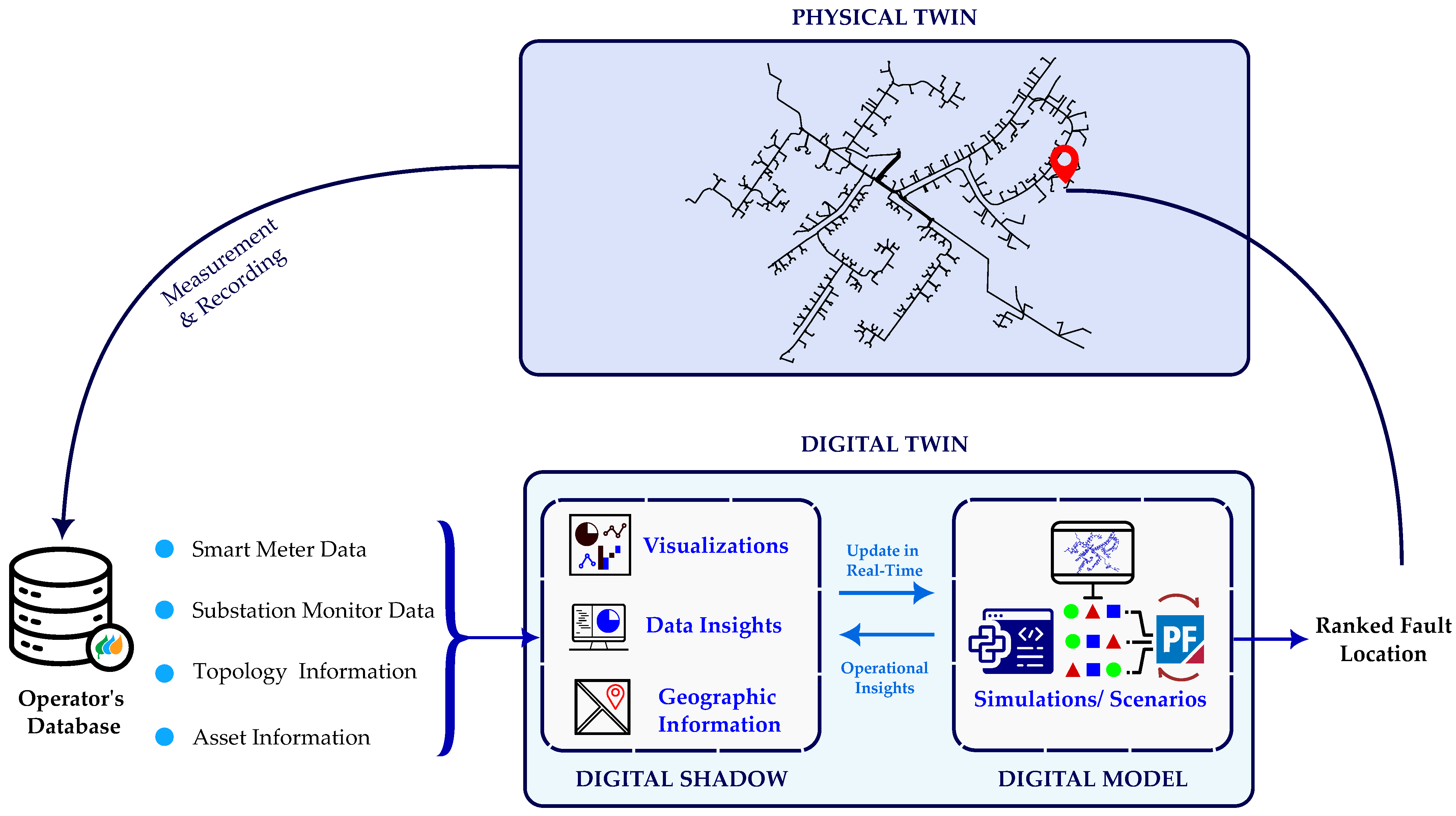
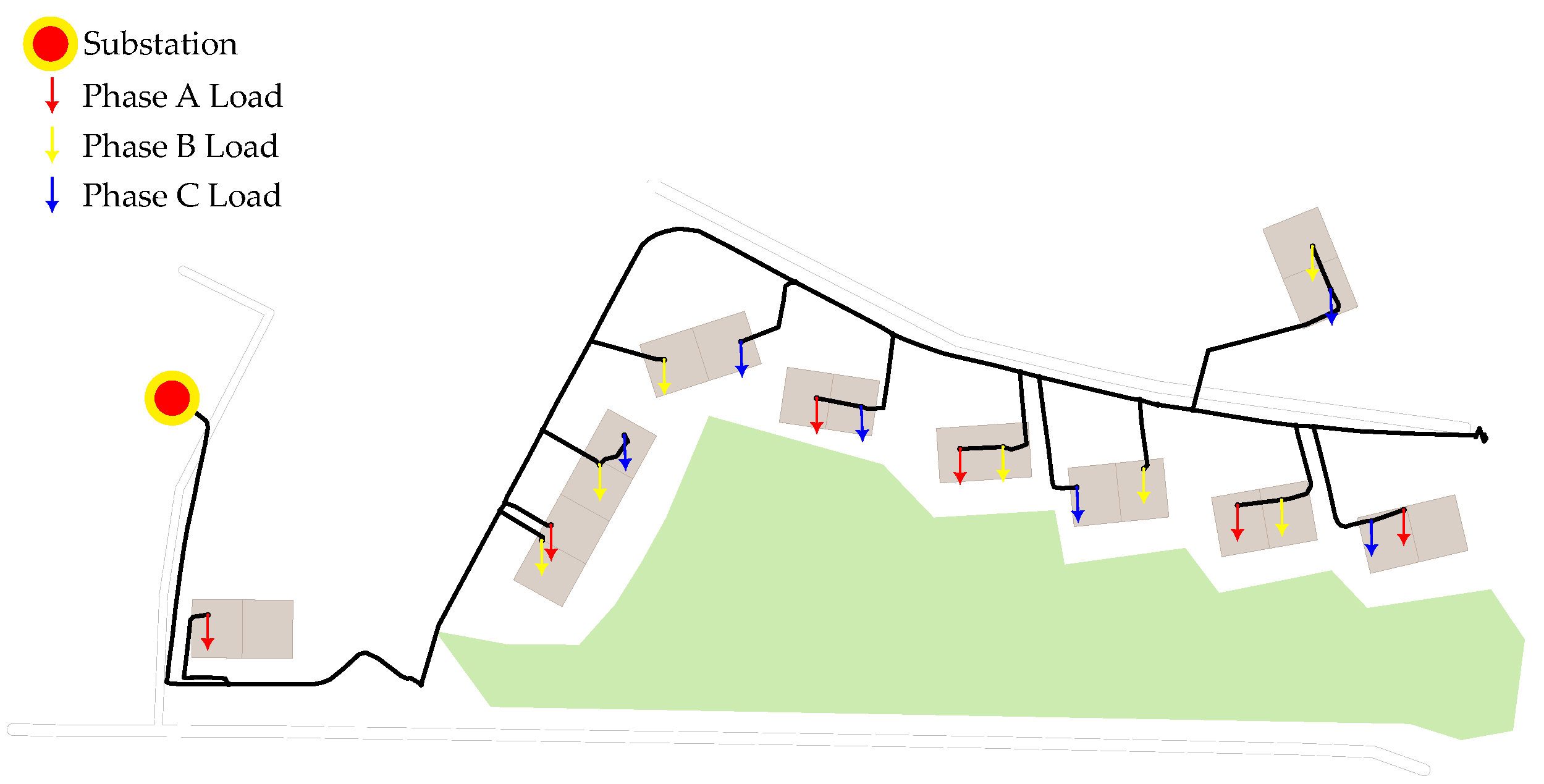
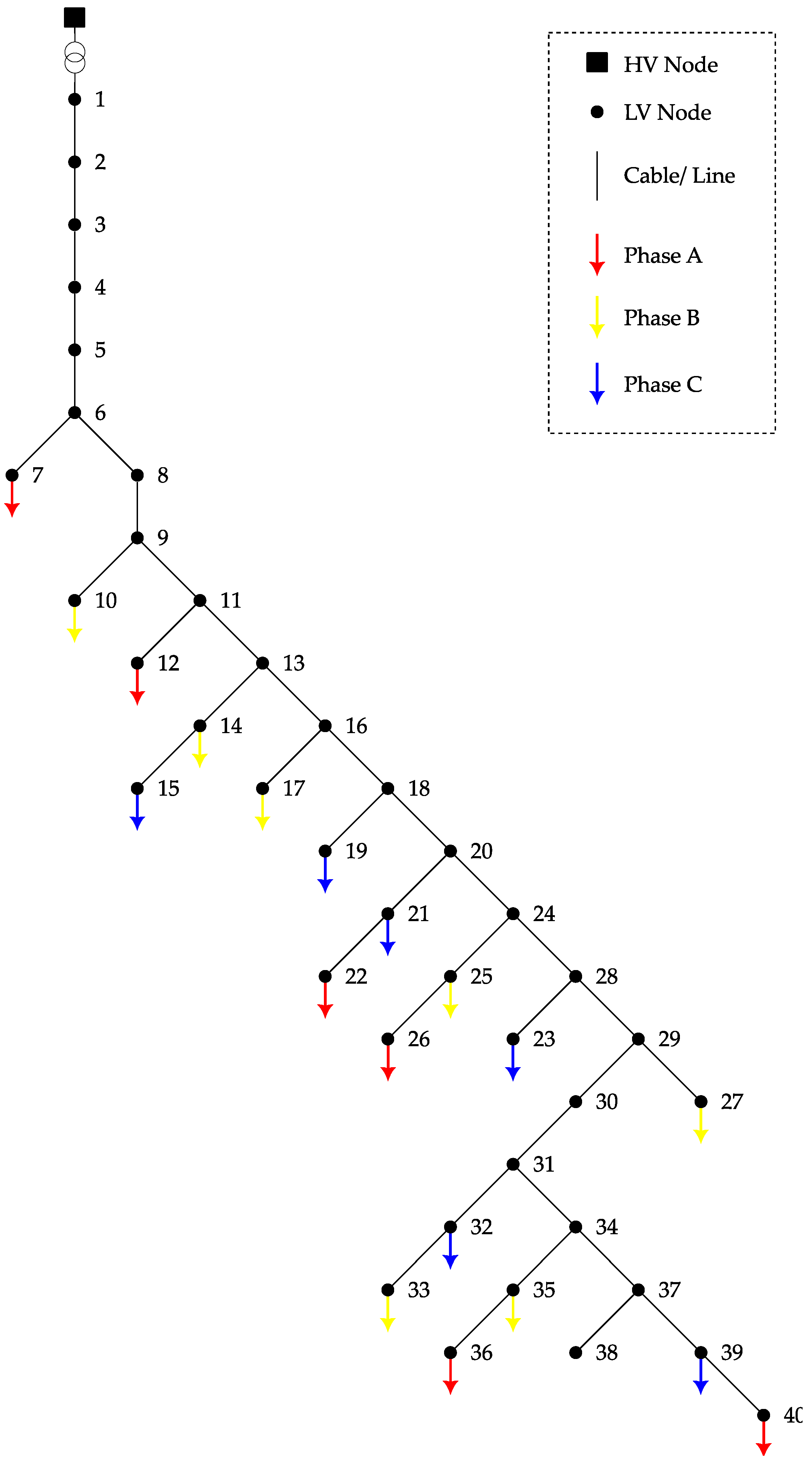
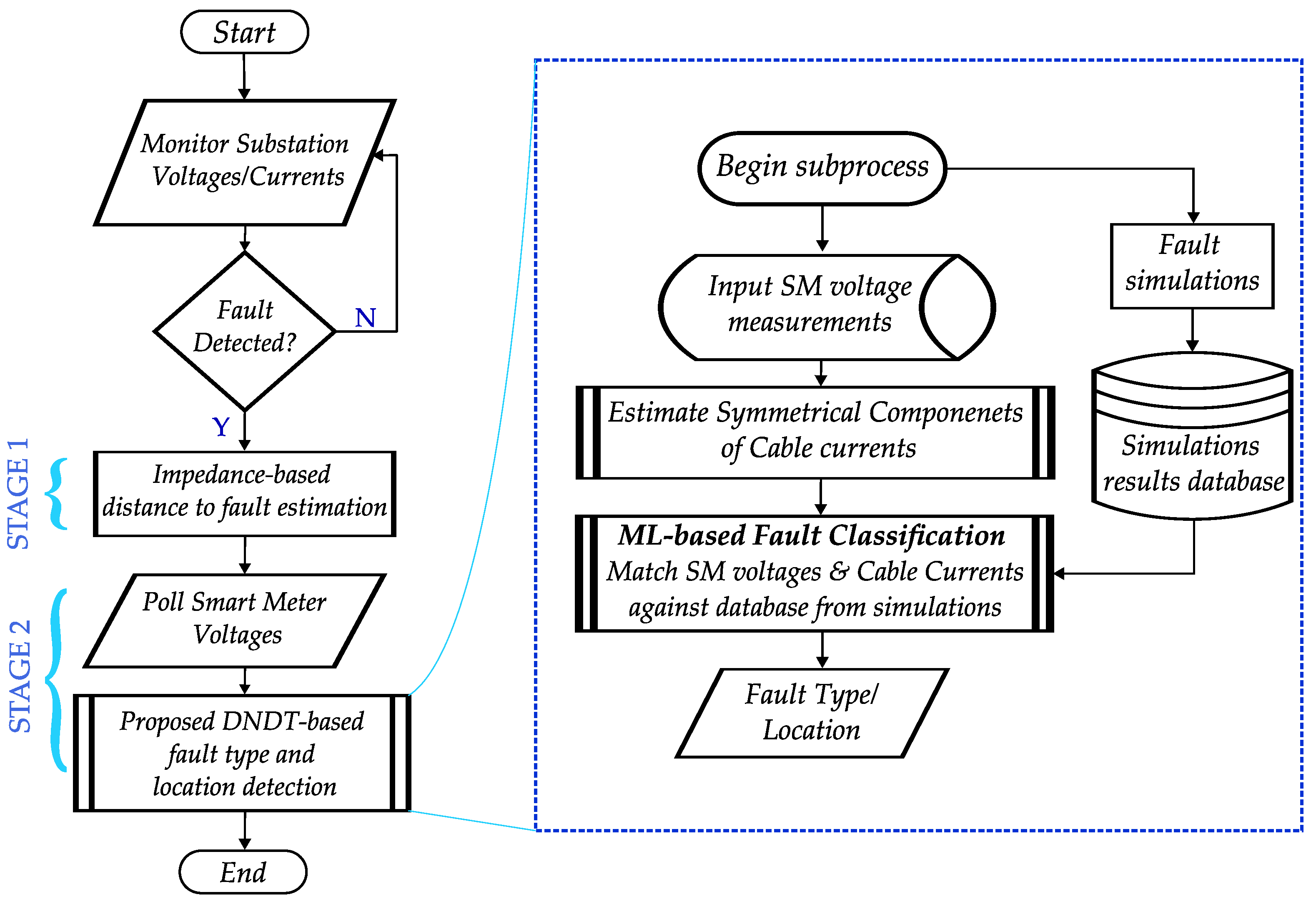
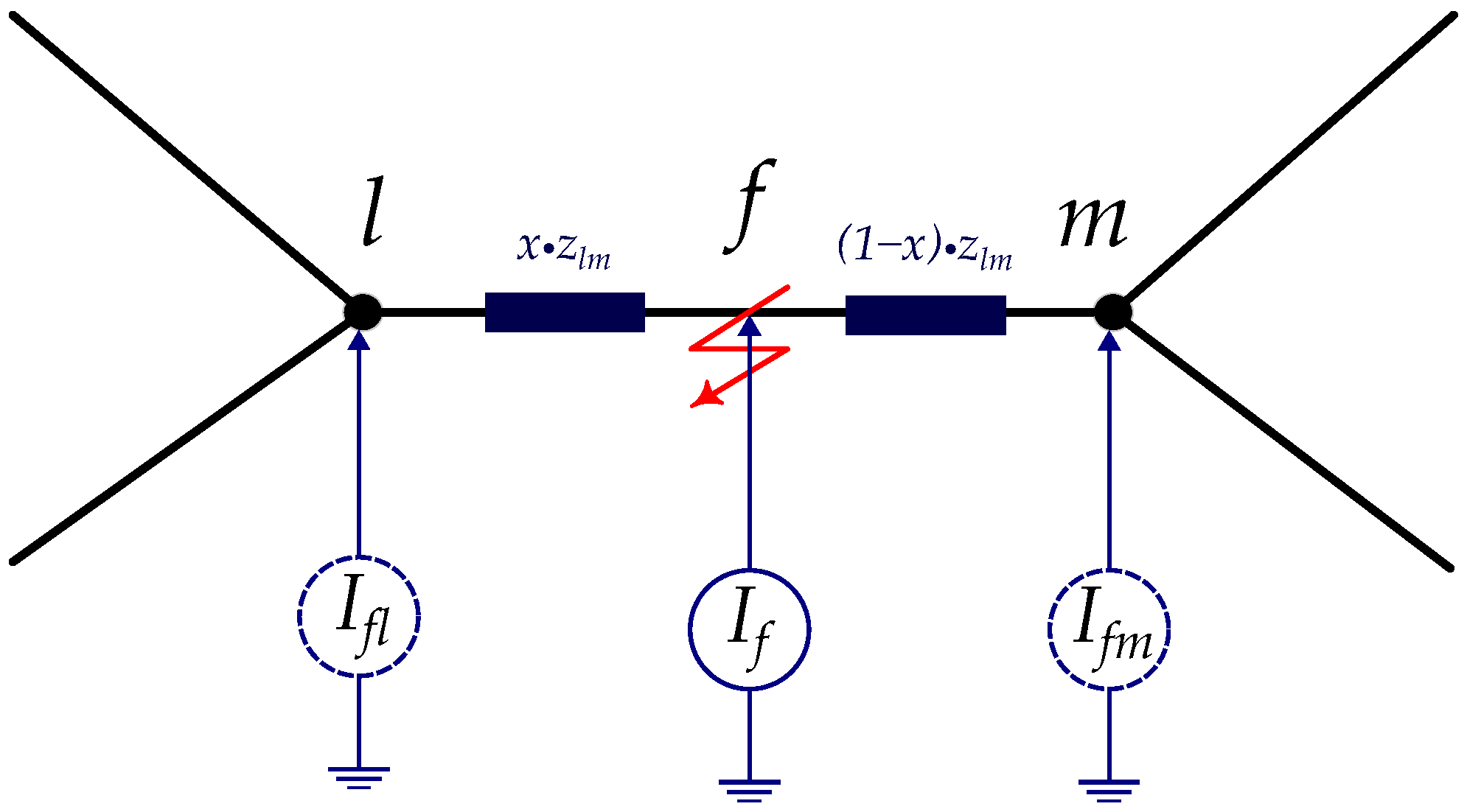
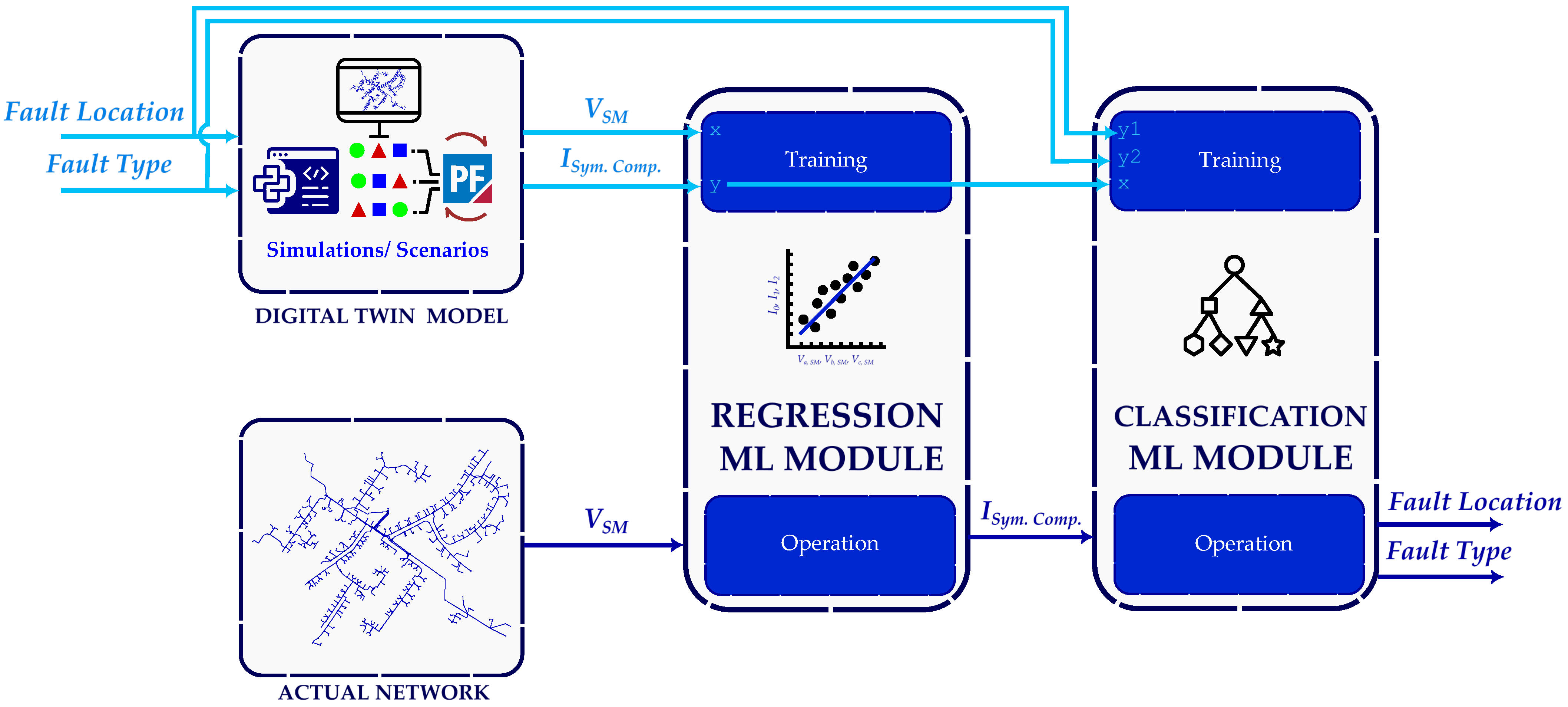
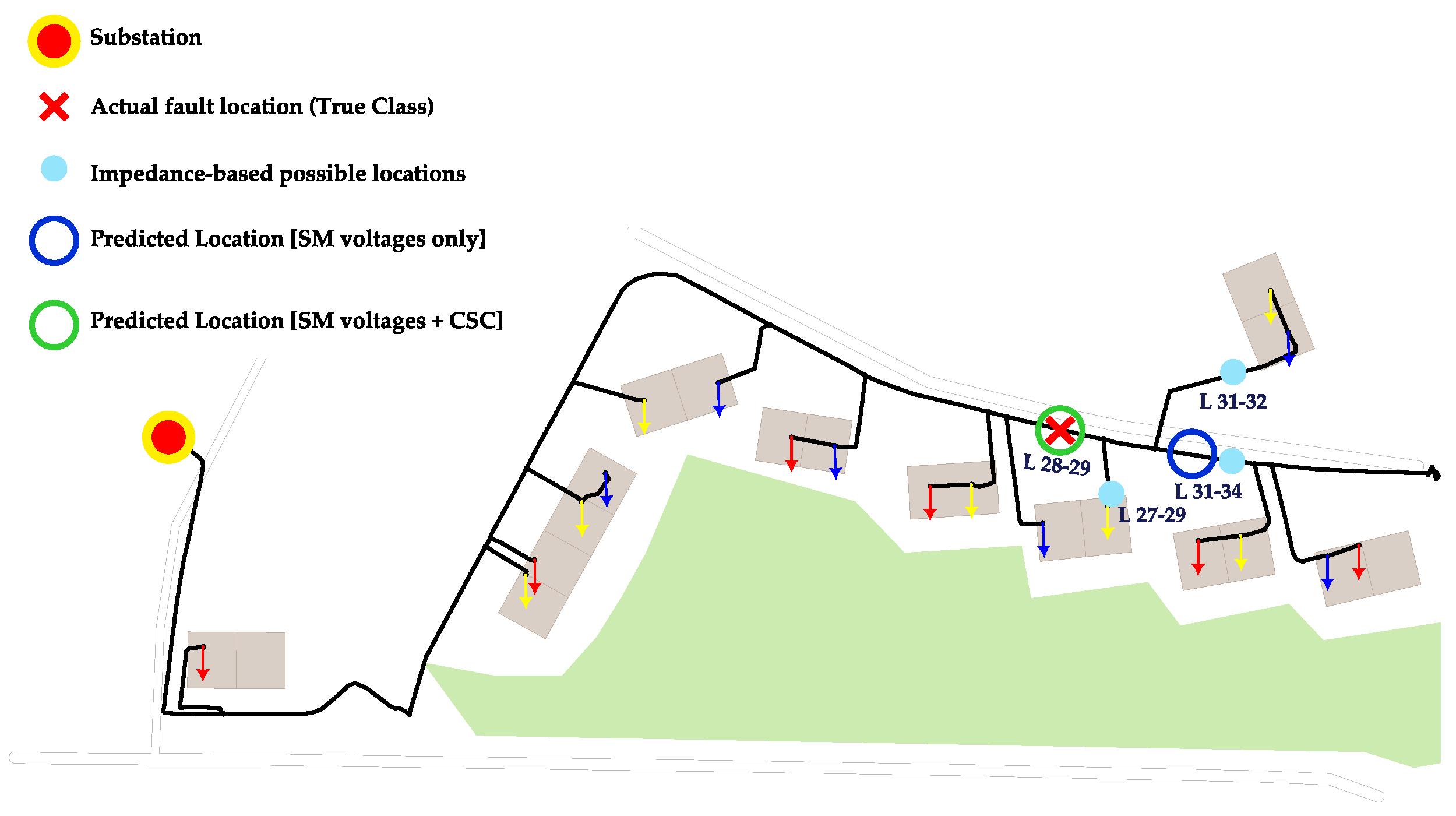
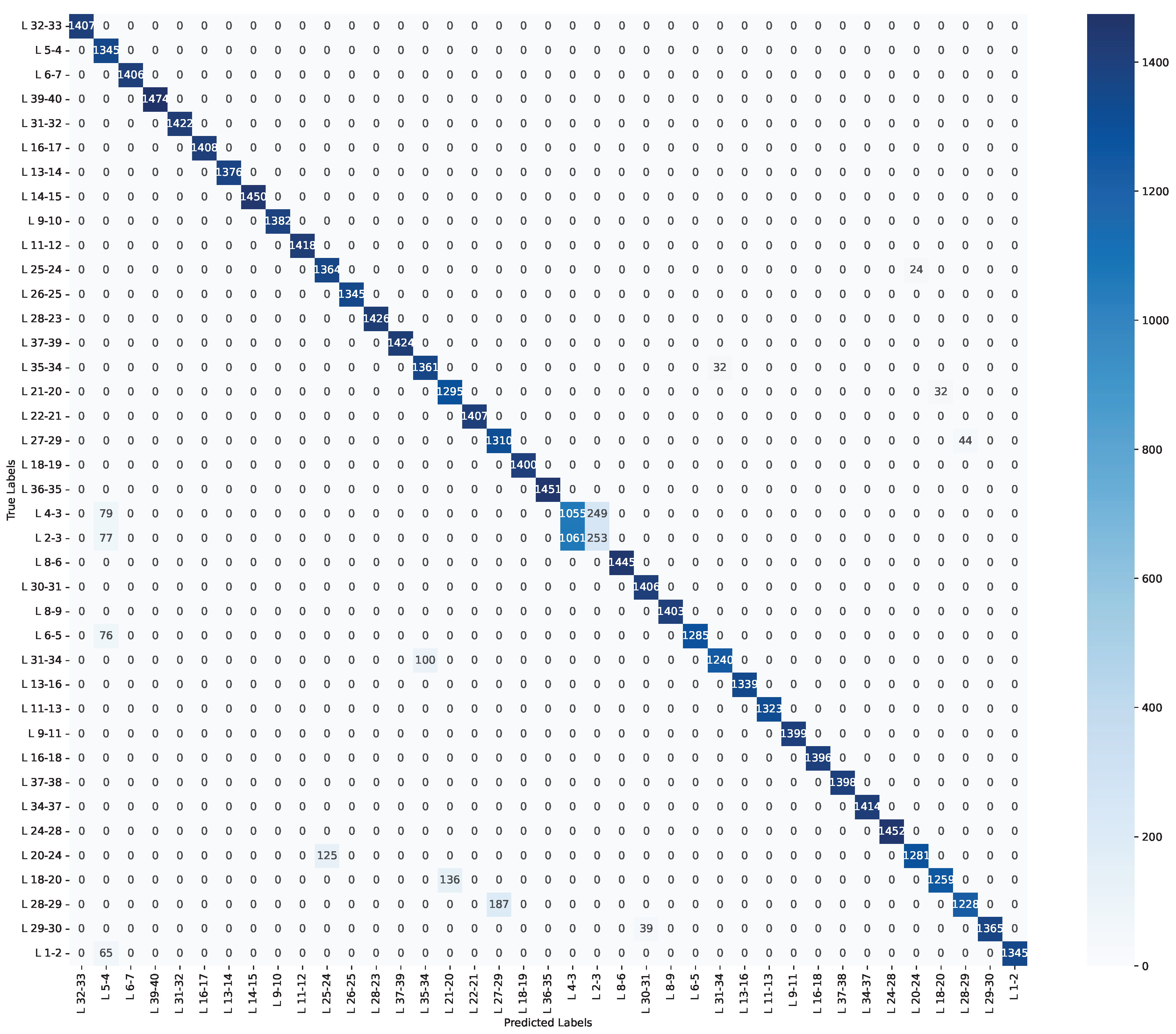
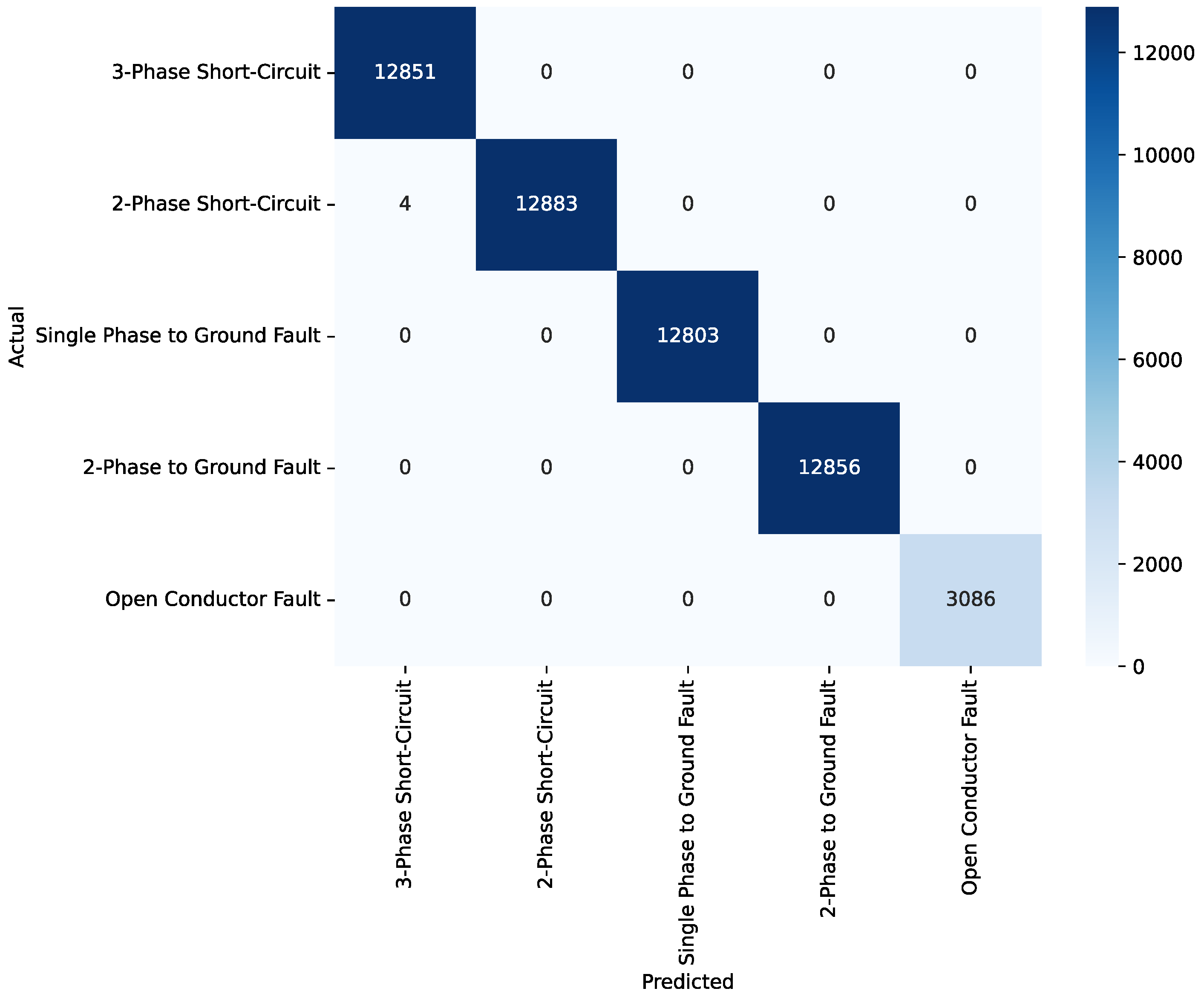
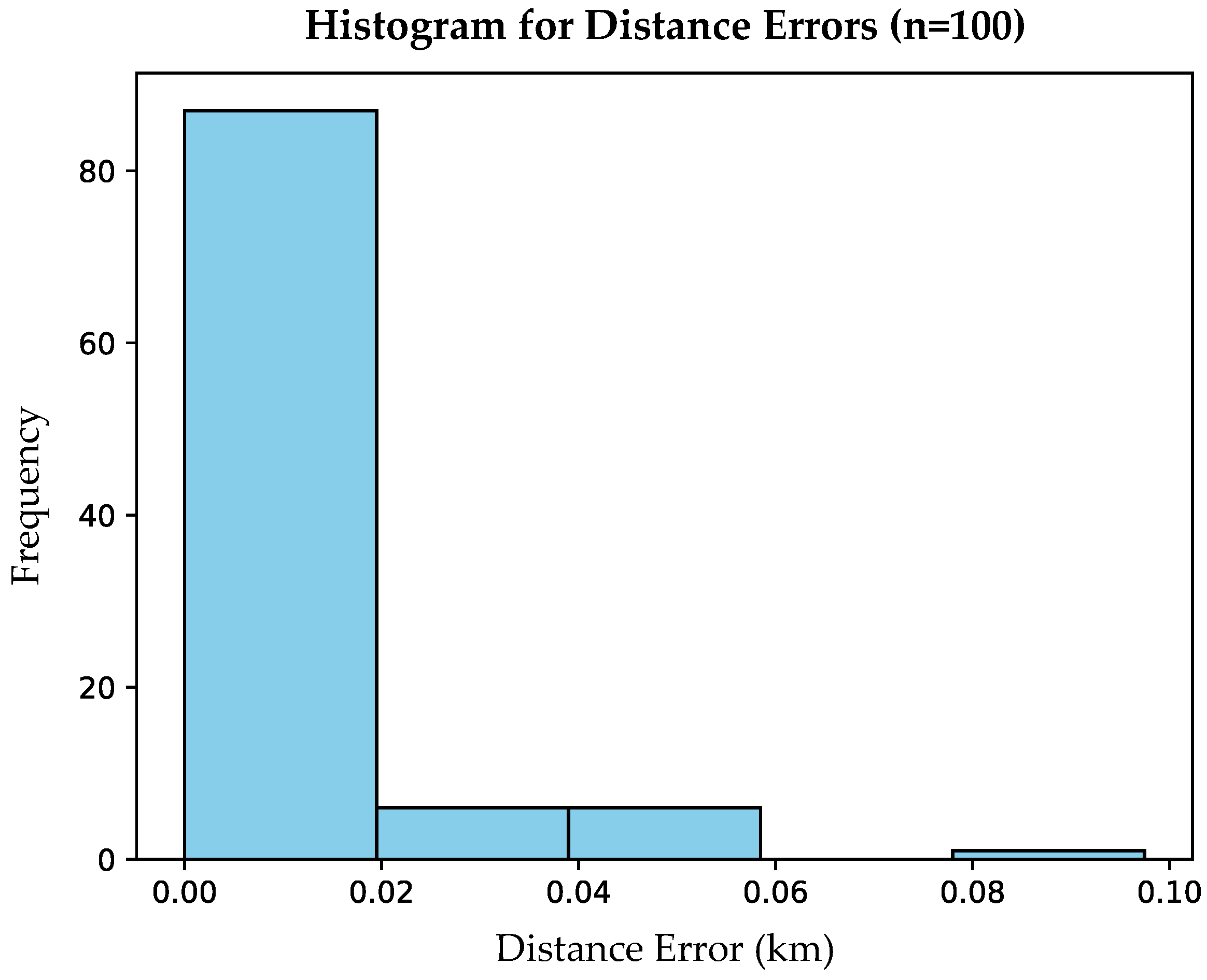

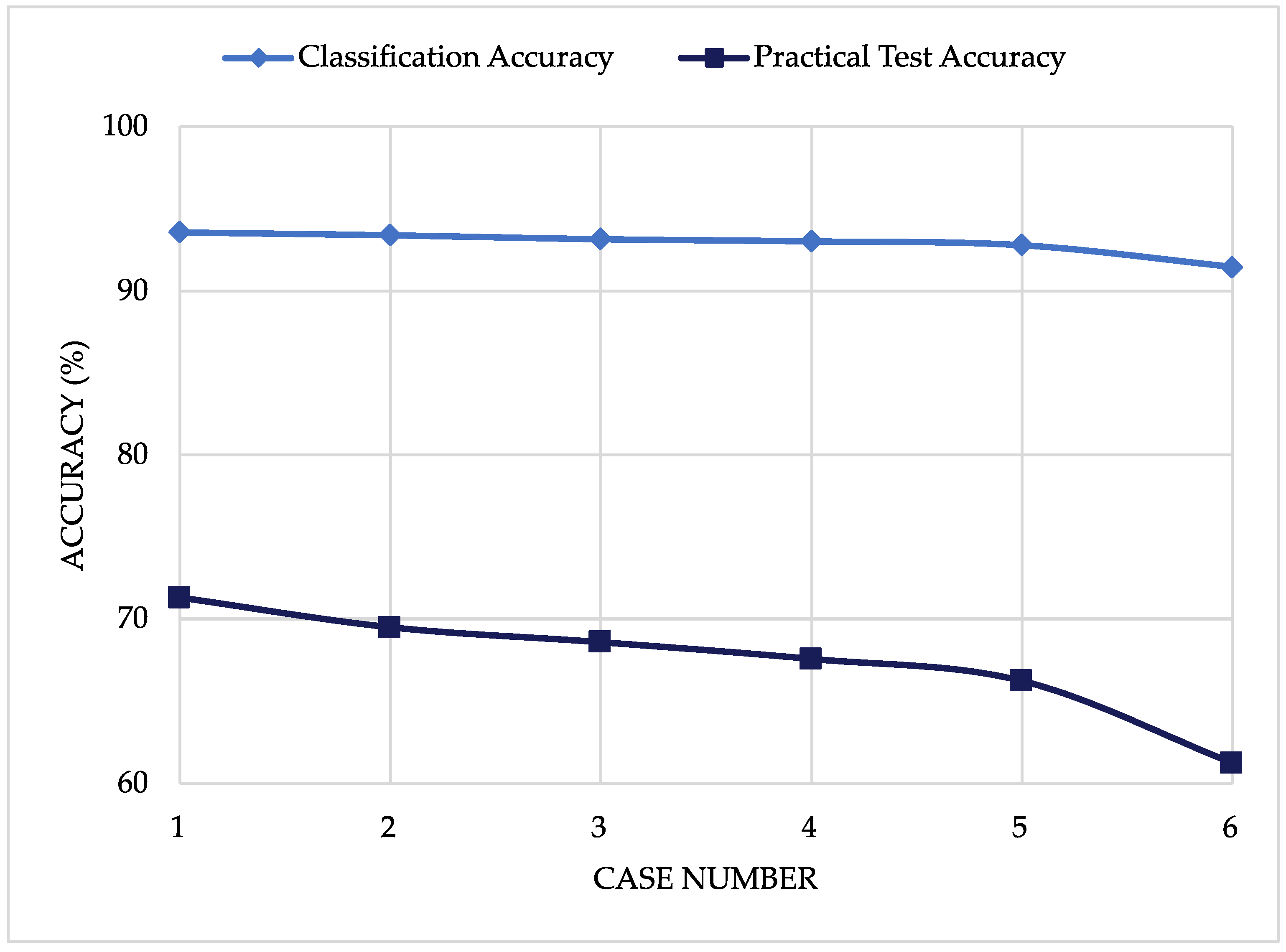
| Index | Cable Name | Cable Length (m) | From Node | To Node |
|---|---|---|---|---|
| 1 | L 1-2 | 0.5 | 1 | 2 |
| 2 | L 2-3 | 0.2 | 2 | 3 |
| 3 | L 4-3 | 1.3 | 4 | 3 |
| 4 | L 5-4 | 5.6 | 5 | 4 |
| 5 | L 6-5 | 47.5 | 6 | 5 |
| 6 | L 6-7 | 18.6 | 6 | 7 |
| 7 | L 8-6 | 31.7 | 8 | 6 |
| 8 | L 8-9 | 28.6 | 8 | 9 |
| 9 | L 9-11 | 1.4 | 9 | 11 |
| 10 | L 9-10 | 7.9 | 9 | 10 |
| 11 | L 11-12 | 7.7 | 11 | 12 |
| 12 | L 11-13 | 12.1 | 11 | 13 |
| 13 | L 13-14 | 9.9 | 13 | 14 |
| 14 | L 14-15 | 4.4 | 14 | 15 |
| 15 | L 13-16 | 15.1 | 13 | 16 |
| 16 | L 16-18 | 41.6 | 16 | 18 |
| 17 | L 18-19 | 13.7 | 18 | 19 |
| 18 | L 18-20 | 16.4 | 18 | 20 |
| 19 | L 22-21 | 6.7 | 22 | 21 |
| 20 | L 21-20 | 14.5 | 21 | 20 |
| 21 | L 20-24 | 19.8 | 20 | 24 |
| 22 | L 26-25 | 6.4 | 26 | 25 |
| 23 | L 25-24 | 14.5 | 25 | 24 |
| 24 | L 24-28 | 3.0 | 24 | 28 |
| 25 | L 16-17 | 11.3 | 16 | 17 |
| 26 | L 27-29 | 10.5 | 27 | 29 |
| 27 | L 28-29 | 15.4 | 28 | 29 |
| 28 | L 29-30 | 2.7 | 29 | 30 |
| 29 | L 30-31 | 5.3 | 30 | 31 |
| 30 | L 31-32 | 32.8 | 31 | 32 |
| 31 | L 31-34 | 15.6 | 31 | 34 |
| 32 | L 28-23 | 19.9 | 28 | 23 |
| 33 | L 32-33 | 6.9 | 32 | 33 |
| 34 | L 36-35 | 6.6 | 36 | 35 |
| 35 | L 35-34 | 14.4 | 35 | 34 |
| 36 | L 34-37 | 2.6 | 34 | 37 |
| 37 | L 37-38 | 29.2 | 37 | 38 |
| 38 | L 37-39 | 19.9 | 37 | 39 |
| 39 | L 39-40 | 5.1 | 39 | 40 |
| Index | Correct Cable | Predicted Cable | Distance Error (km) |
|---|---|---|---|
| 1 | L 31-32 | L 31-32 | 0.000000 |
| 2 | L 37-38 | L 37-38 | 0.000000 |
| 3 | L 16-17 | L 16-17 | 0.000000 |
| 4 | L 35-34 | L 35-34 | 0.000000 |
| 5 | L 8-6 | L 8-6 | 0.000000 |
| 6 | L 26-25 | L 26-25 | 0.000000 |
| 7 | L 8-6 | L 8-9 | 0.015661 |
| 8 | L 5-4 | L 5-4 | 0.000000 |
| ⋮ | ⋮ | ⋮ | ⋮ |
| 94 | L 34-37 | L 37-38 | 0.020891 |
| 95 | L 13-14 | L 14-15 | 0.000737 |
| 96 | L 34-37 | L 37-38 | 0.020891 |
| 97 | L 6-5 | L 6-5 | 0.000000 |
| 98 | L 16-18 | L 16-18 | 0.000000 |
| 99 | L 16-17 | L 16-17 | 0.000000 |
| 100 | L 13-16 | L 13-16 | 0.000000 |
Disclaimer/Publisher’s Note: The statements, opinions and data contained in all publications are solely those of the individual author(s) and contributor(s) and not of MDPI and/or the editor(s). MDPI and/or the editor(s) disclaim responsibility for any injury to people or property resulting from any ideas, methods, instructions or products referred to in the content. |
© 2023 by the authors. Licensee MDPI, Basel, Switzerland. This article is an open access article distributed under the terms and conditions of the Creative Commons Attribution (CC BY) license (https://creativecommons.org/licenses/by/4.0/).
Share and Cite
Numair, M.; Aboushady, A.A.; Arraño-Vargas, F.; Farrag, M.E.; Elyan, E. Fault Detection and Localisation in LV Distribution Networks Using a Smart Meter Data-Driven Digital Twin. Energies 2023, 16, 7850. https://doi.org/10.3390/en16237850
Numair M, Aboushady AA, Arraño-Vargas F, Farrag ME, Elyan E. Fault Detection and Localisation in LV Distribution Networks Using a Smart Meter Data-Driven Digital Twin. Energies. 2023; 16(23):7850. https://doi.org/10.3390/en16237850
Chicago/Turabian StyleNumair, Mohamed, Ahmed A. Aboushady, Felipe Arraño-Vargas, Mohamed E. Farrag, and Eyad Elyan. 2023. "Fault Detection and Localisation in LV Distribution Networks Using a Smart Meter Data-Driven Digital Twin" Energies 16, no. 23: 7850. https://doi.org/10.3390/en16237850
APA StyleNumair, M., Aboushady, A. A., Arraño-Vargas, F., Farrag, M. E., & Elyan, E. (2023). Fault Detection and Localisation in LV Distribution Networks Using a Smart Meter Data-Driven Digital Twin. Energies, 16(23), 7850. https://doi.org/10.3390/en16237850











